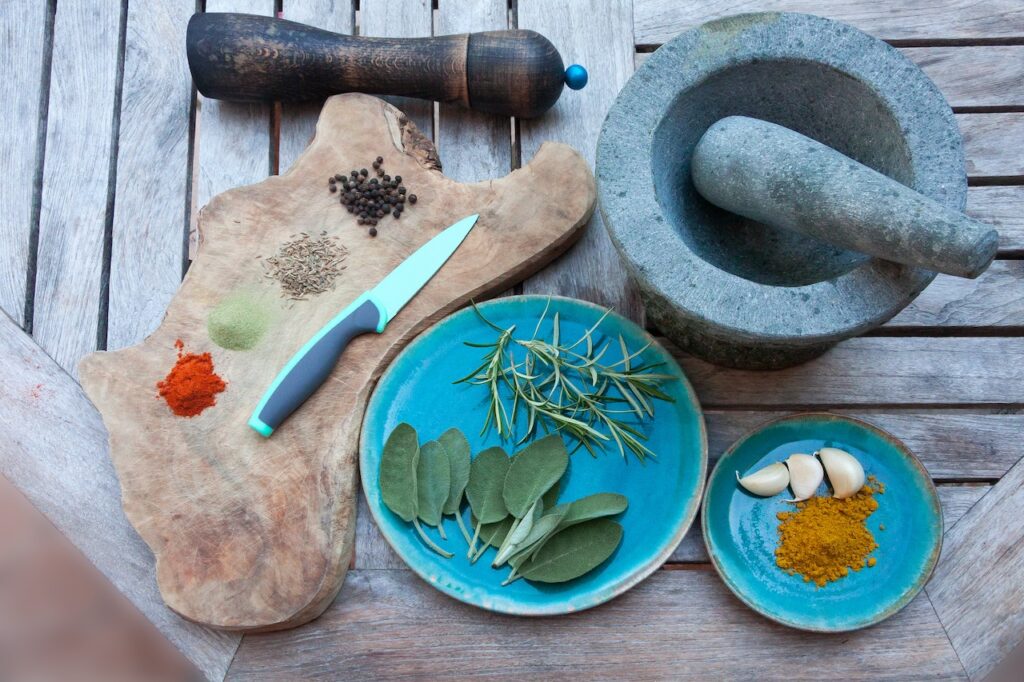When cooking at home, most people rely heavily on seasonings they are familiar with and already have in their pantry. However, there are hundreds of spices used in other cultures that can add a little excitement and flavor to any dish, if given a chance. Let’s dive in and see if some new spices can whet your appetite.
Cardamom
Cardamom is a widely used spice in Middle Eastern, Indian, Arabic, and Swedish cuisines. It is one of the most expensive spices in the world, behind saffron and vanilla, because of its laborious harvesting process and rarity. There are two main types of cardamom: black and green, although the latter is considered “true” cardamom.
Green cardamom has a strong, sweet flavour with hints of mint and lemon, and is typically used in desserts or hot beverages. It is also great in savoury dishes. Black cardamom has a smoky and cooling menthol taste that is more appropriate for recipes like curry.
Clove
Cloves, or cengkih, are native to the Maluku Islands or “spice islands” of Indonesia and have a long history of use and value worldwide. Envoys visiting Chinese emperors would use cloves to improve their breath as early as 200 BCE. It was also a valuable spice, and the Dutch held a clove monopoly between the 17th and 18th centuries.
The taste of cloves is sweet and bitter, with a bit of heat and a strong, pungent aroma, so be mindful when using it sparingly. Traditional Indian cuisine often includes whole or ground cloves to flavour sauces, soups, and rice dishes. In North America and Europe, cloves are prevalent in Christmas holiday dishes alongside cinnamon or nutmeg.
Aji Amarillo
In Spanish, “aji” means “chilli,” and “amarillo” means “yellow,” so this staple of Peruvian cooking is also known as the “yellow pepper.” It is part of Peruvian cuisine’s “holy trinity” alongside garlic and red onion. Aji amarillo is a moderately hot chilli pepper that registers between 30,000 to 50,000 units on the Scoville scale, which is in the same range as tabasco or cayenne peppers.
The pepper has a unique, fruity flavour, sometimes equated to passionfruit or mango, which makes it an excellent pairing for savoury or sweet dishes. Aji amarillo is prevalent in many traditional poultry, seafood, and root vegetable dishes. It also works well as a condiment and is often mixed into creamy dipping sauces.
Galangal
Galangal is commonly mistaken for ginger due to its similar appearance. It derives its name from a Chinese phrase meaning “good ginger from Gaoshou.” Two variations of the plant, referred to as greater and lesser galangal, are native to Indonesia and China, respectively.
The flavour is less spicy than ginger, with distinct pepper, citrus, and pine notes. Galangal’s strong flavour should be used sparingly, and is ideal for curries, soups, stir-fries, and sauces. It is a common ingredient in Thai and Vietnamese seafood dishes due to its ability to mask fishy flavours. Fresh galangal gets tougher over time, so remember to grate finely or slice thinly when using it.
Shichimi Togarashi
Shichimi togarashi is a Japanese blend of spices that commonly includes red chilli pepper, black and white sesame seeds, poppy seeds, ginger, sansho, Sichuan pepper, orange peel, and nori seaweed. Excluding nori, the blend combines seven spices, named “shichi” for “seven” and “togarashi” for “peppers.” Spices within the mixture can vary depending on the recipe, but the most important is the red chilli pepper.
This mixture is highly versatile and well-suited for many savoury and sweet dishes. Shichimi togarashi adds spice and umami to any dish and is used to make sauces and soups. One of its best uses is sprinkling it over noodles, grilled meats or fish, and snacks like popcorn and fries.
Sumac
Native to and popular in the Middle East, sumac is a red berry that is dried out and ground into a powder. Arabic and Lebanese cuisines use it as an acidulant that helps bring out the natural flavours of a dish’s ingredients. Be sure not to confuse it for the related sumac plant with white berries, which are poisonous.
Sumac’s flavour is bold and lemony, bringing acidity and tartness to a dish and a pink hue. Use it in anything, such as dry meat rubs, vinaigrette salad dressings, and dips. However, its best use is sprinkling it over your food like you would a squeeze of lemon juice.
Nigella Seeds
Commonly found in Indian, Middle Eastern, and North African cuisines, nigella seeds are also known as kalonji, charnushuka, or, mistakenly, black cumin or onion seeds. It is also one of the spices in panch phoran (meaning “five spices”), a popular blend in Eastern India and surrounding areas.
The flavour of nigella seeds is similar to oregano and toasted onions, making it an ideal topping for baked bread. They are a good substitute for sesame seeds, so do not hesitate to sprinkle them on eggs, salads, and crackers. Adding nigella seeds to savoury and dairy snacks like scones or yogurt provides an enjoyable, flavourful crunch. Seasoning stir-fries, curries, and pickles is an optimal way to use them as well.
Pink Himalayan Salt
Pink Himalayan salt gets its distinctive hue by mixing in minerals and red clay during its processing. It is similar to table salt, except less refined, and can contain up to 84 trace elements of various minerals. Pink salt also comes in larger crystal sizes, so crush them with a pestle and mortar or spice grinder before use.
While pink Himalayan salt can act as a substitute for table salt, its mild flavour lends it greater versatility. Himalayan salt blocks conduct and retain heat well for cooking while still imparting flavour. The salt also has a slightly floral taste, making it perfect for finishing sweet desserts or savoury meats and seafood.
Vanessa Huasasquiche | Contributing Writer










